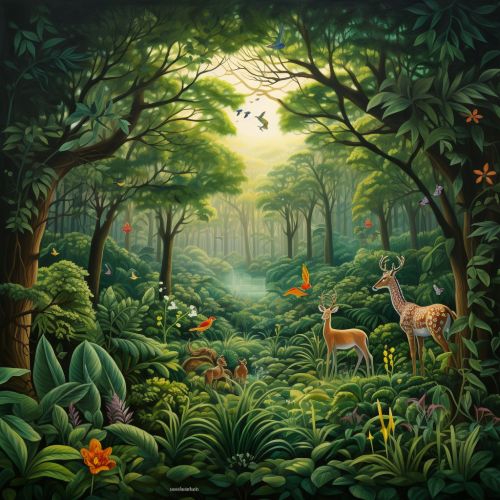Flora and fauna
Introduction
Flora and fauna are terms used to denote the plant and animal life in a particular region or time. The word 'flora' is derived from the Latin name of Flora, the goddess of plants, flowers, and fertility in Roman mythology. Fauna, on the other hand, is derived from the name of Fauna, a Roman goddess of earth and fertility, as well as the daughter of Fauna, the Roman god of animals. Together, flora and fauna represent the biodiversity of an ecosystem.


Flora
Flora refers to all plant life in a specific area or time period. This includes flowering plants, ferns, mosses, and other non-flowering plants. The study of flora, including the classification, description, and interaction of plant species, is known as botany. Botanists often divide flora into categories such as native flora, agricultural and garden flora, and weed flora, each with its own unique set of characteristics and adaptations.
Native Flora
Native flora refers to the plants that are indigenous to a specific region. These plants have evolved over thousands of years in a particular geographic and climatic condition, and they are adapted to the local soil, climate, and other environmental factors. Native flora plays a crucial role in maintaining biodiversity, providing habitat for wildlife, and contributing to the health of ecosystems.
Agricultural and Garden Flora
Agricultural and garden flora refers to the plants that are grown by humans for various purposes. Agricultural flora includes crops such as wheat, rice, and corn, which are grown for food production. Garden flora, on the other hand, includes ornamental plants, trees, and shrubs that are grown for their aesthetic value.
Weed Flora
Weed flora refers to plants that are considered undesirable in a particular context. These are typically plants that grow aggressively, spread rapidly, and compete with other plants for resources. Despite their negative connotation, some weed flora can have beneficial effects on the environment, such as improving soil fertility or providing habitat for certain wildlife species.
Fauna
Fauna refers to all animal life in a specific area or time period. This includes mammals, birds, reptiles, amphibians, insects, and other invertebrates. The study of fauna, including the classification, description, and behavior of animal species, is known as zoology. Zoologists often divide fauna into categories such as terrestrial fauna, aquatic fauna, and aerial fauna, each with its own unique set of characteristics and adaptations.
Terrestrial Fauna
Terrestrial fauna refers to the animals that live on land. These animals have evolved various adaptations to survive in different terrestrial habitats, such as forests, deserts, mountains, and grasslands. Terrestrial fauna includes a wide variety of species, from large mammals like elephants and tigers to small insects and spiders.
Aquatic Fauna
Aquatic fauna refers to the animals that live in water. These animals can be found in a variety of aquatic habitats, including oceans, rivers, lakes, and ponds. Aquatic fauna includes a wide range of species, from large marine mammals like whales and dolphins to small fish and invertebrates.
Aerial Fauna
Aerial fauna refers to the animals that are capable of flight. These animals include birds, bats, and certain insects. Aerial fauna have evolved various adaptations for flight, such as wings, light body weight, and specialized respiratory systems.
Importance of Flora and Fauna
Flora and fauna play a crucial role in maintaining the health of our planet. They contribute to biodiversity, which is essential for ecosystem stability and resilience. Flora, through the process of photosynthesis, produces oxygen, which is essential for the survival of most life forms. It also plays a key role in the carbon cycle, helping to mitigate climate change by absorbing carbon dioxide from the atmosphere.
Fauna, on the other hand, contributes to the food chain and nutrient cycling. Animals help in the pollination of plants, dispersal of seeds, and decomposition of organic matter. They also serve as indicators of environmental health, as changes in animal populations can signal changes in the environment.
Threats to Flora and Fauna
Flora and fauna worldwide are under threat due to various human activities. Habitat destruction, climate change, pollution, overexploitation, and the introduction of invasive species are some of the major threats to biodiversity. These threats can lead to the extinction of species and the degradation of ecosystems, with serious implications for the health of our planet.
Conservation of Flora and Fauna
Conservation of flora and fauna is crucial for maintaining biodiversity and the health of our planet. This can be achieved through various strategies, such as the establishment of protected areas, habitat restoration, sustainable resource management, and the regulation of hunting and fishing. Education and awareness-raising are also important for promoting the conservation of flora and fauna.
